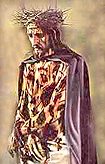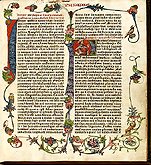 For the last several years, three news magazines, Time, Newsweek and U.S. News & World Report have published numerous cover articles and special editions that cumulatively have discredited or distorted the Gospels and the life of Christ. Add that to plays, movies and TV shows and we can easily see a mammoth onslaught against the Catholic religion. While it is unfashionable these days to show that all these attacks are interconnected, the evidence supports this conclusion, however uncomfortable it may make us feel. Since space will not allow us to connect all these dots, we will focus our attention on the news magazines, related books and their inspiration: Gnosticism.
For the last several years, three news magazines, Time, Newsweek and U.S. News & World Report have published numerous cover articles and special editions that cumulatively have discredited or distorted the Gospels and the life of Christ. Add that to plays, movies and TV shows and we can easily see a mammoth onslaught against the Catholic religion. While it is unfashionable these days to show that all these attacks are interconnected, the evidence supports this conclusion, however uncomfortable it may make us feel. Since space will not allow us to connect all these dots, we will focus our attention on the news magazines, related books and their inspiration: Gnosticism.
Gnosticism surfaced as a pernicious anti-Christian movement during the first centuries of the Church. Many of the great theological works by the early Church Fathers such as Saint Irenaeus and Tertullian were written in response to the enticing novelties of Gnostic thought and their heretical forgeries sometimes called the apocryphal (spurious) gospels. In this essay we are using the term to cover several occult pagan sects (the Manichees, the Paulicians, the Albigenses etc.) which arose over the centuries in opposition to the doctrine of a visible hierarchical Church based on Divine Revelation.
An examination of the conflicting and inconsistent views of the various sects would be unproductive and tedious, but central to all of them is that salvation comes from a secret, higher form of knowledge accompanied by a cosmic, mystical encounter that frees the divine spark in all of us. The previously captured self-expression is then freed and the soul can turn inward to arrive at a purely subjective religious experience. Gnostics also deny the validity of the Old Testament and what they accept of the New is filtered through their own confused ideas.
Many of the anti-Catholic movements since the Middle Ages from Protestantism to Communism share many ideas with the Gnostics. Edward Gibbons, the famous English historian, commented that the Paulicians, “scattered over the West the seeds of Reformation.” This is especially true in the negative sense since both minimized the Sacraments, condemned the invocation of the saints and denied miracles and the fact that the Virgin Mary was the Mother of God. Both Gnostics and communists believe that evil in the world is caused by inequalities and that man must liberate himself by erasing all inequality through a long process of evolution.
Higher Critics
The attack on Church teaching based on the traditional Gospels of Matthew, Mark, Luke and John has a long history. A group of so-called scholars with a preconceived hostility toward the authenticity of the New Testament and its supernatural elements emerged in the last half of the eighteenth century. Influenced by the same ideas that brought on the French Revolution (the Enlightenment), these rationalists denied the divinity of Christ and Revelation in general since it was inconsistent with their belief that all truth only comes from the human mind. This would completely eliminate the obligations imposed on us by Christ as God-man. The higher critics, as they were known, also denied the traditional authorship of the Gospels by relying on the study of internal language and ignoring the extensive historical documentation.
Although these extremist spiritual interpreters found a sympathetic audience among the usual “well-educated” nonconformists, their audience was small. But a chance discovery which nurtured irreligion and secularization in the age of expanding mass media resulted in a much larger following.
The Gnostic gospels
In 1945 in a field near the Egyptian town of Nag Hammadi, a group of Arab peasants found a large earthenware jar containing over fifty Coptic, Gnostic writings in thirteen leather-bound books. Concealed in the late fourth century, the texts proved to be the library of a Gnostic sect that claimed to have secret knowledge of Jesus. The news media treated the discoveries in a sensational fashion, especially when English translations began to appear in 1950’s. The Gospel of Thomas, the most often-quoted, was published in English in 1959 to overwhelming acclaim and publicity. All the texts were published by 1977 and considered just as precious as or even more precious than the canonical New Testament by those who sought a new Christianity.
As more radical “scholars” entered the field, news magazines and major publishers encouraged a taste for subversive interpretations of Christian origins. The early Church Fathers are seen as vindictive when they placed the heretical gospels among the apocrypha (spurious works) allegedly motivated by unjust political considerations. But the historical evidence shows that the Catholic Church was indeed established by Christ to teach in his name and the canonical books are a result of Divine Revelation and not political expediency.
It is no wonder that modern Gnostics ignore the historical documents, for they see Jesus more as a psychological reality sent by heaven to liberate the forces of light in all of us. They reject the concept of sin and judgment and seek mystical illumination. To them Jesus was not the Messias but a social radical who brought a counter-cultural message that promoted equality and diversity.
Since we are dealing with perceptions of an inward-turning modern culture which sees things in subjective terms, there will naturally be a feminist element involved. Just as the new “scholars” used the Gnostic gospels to distort the traditional Scriptures, so the feminists use them to correct what they regard as a male misreading of the traditional text. They see in their favorite, the Gospel of Mary, an indication that women in the early Church were apostles, leaders and teachers, and that Mary Magdalene was unfairly treated because she threatened Saint Peter’s status. Along with their male counterparts, they are also attracted to the Gnostic concept of spirituality without the involvement of organized religion or dogma.
While all these denigrations of the Gospels are receiving ample support from the mass media, the most shameless recent example of Catholic bashing is the popular novel The DaVinci Code by Dan Brown. At this writing (early days of the New Year) it has been on The New York Times Best Seller List for thirty-nine weeks, sitting at the top for six. Carrying the Gnostic gospels a step further, Brown has interwoven in his contemporary murder mystery the blasphemous and repugnant assertion that Our Lord was married to Mary Magdalene and had a child by her.
Christ suffered a cruel persecution, torture and an ignominious death at a specific moment in historical time. To the modern Gnostics, who have great influence over the mass media, the Passion and crucifixion are not real events but have only a symbolic and mythological character. Their interpretations have been spread far beyond the theological world and have been embraced by all sorts of feminists, evolutionists, environmentalists and occultists. They look forward to a New Age that transcends time and the boundaries of space.

the rest.
Authorship of the Gospels
One of the most pernicious ideas spread by the news media is skepticism about the traditional authorship of the four Gospels. Many times a writer will hypocritically lament that we just don’t know who wrote them, all the while ignoring volumes of historical documents. There is more manuscript evidence supporting the integrity, authorship and historicity of the Gospels than any work of classical literature (over which, of course, nobody raises any doubts).
Tertullian of Carthage, Saint Irenaeus of Lyon, Origen of Alexandria, all wrote apologetical works that show that Matthew published his Gospel among the Hebrews initially in their language; that Mark, a pupil and interpreter of Saint Peter, had written down what he had preached; that Luke, a companion of Saint Paul, wrote for the Gentiles what he had from that Apostle; and lastly that John, who reclined on Our Lord’s breast, published his Gospel while residing at Ephesus in Asia.
The task of investigating the truth of the events of the Gospels for the early Christians was not difficult. The details of Christ’s life were widely known. The Christians accepted the books of Matthew, Mark, Luke and John and rejected the rest. They were quite satisfied with the message that Christ was God and had come to tell us what we must do and believe to be saved.

